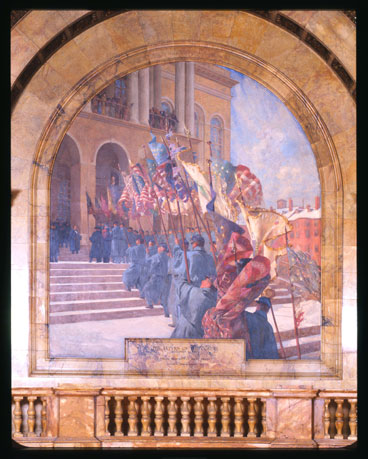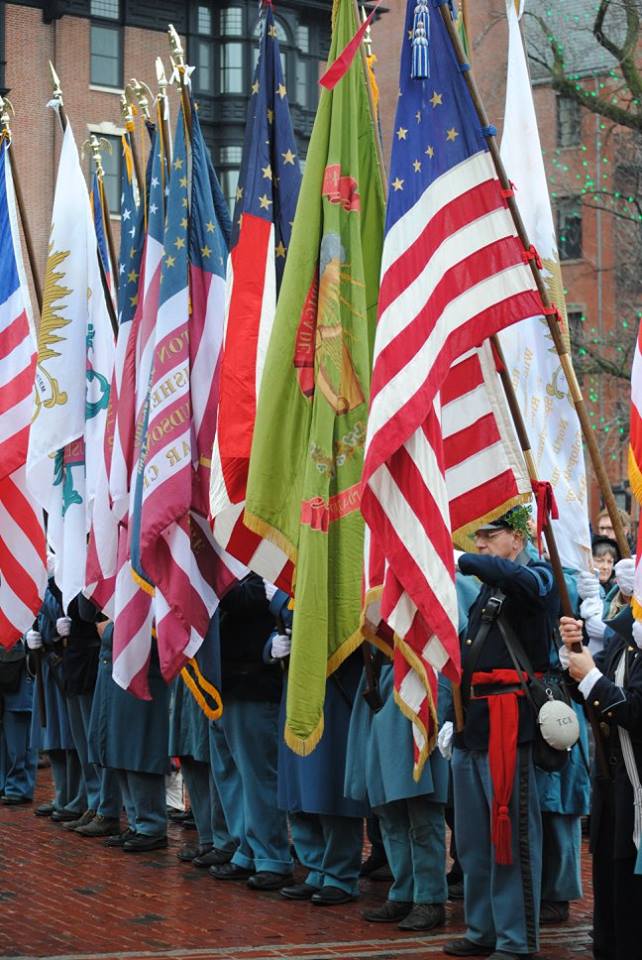
It is not often that we get to participate in a once in a lifetime event but recently I had just that opportunity. On December 22, 1865, representatives of the regiments from Massachusetts assembled on the Boston Common. They had survived four years of war and were now safe at home and would be able to gather with family and friends for Christmas. But they had one more job to do, they had to return their battled scarred flags to the Governor of Massachusetts.
It had been the custom, since the Revolutionary War, for the Governor of Massachusetts to present each regiment with their flag as they departed for battle. These colors would become the symbol of their honor and a rallying cry on the battlefield. During the confusion of battle, a soldier would be able to see his regimental colors flying in the wind and know where his comrades were at all times. The soldier that carried the colors was out in front, with no weapon to defend himself, and was very often the one who was shot first as the units marched across the field. Each man that took that flag in his hands knew the fate that he was certain to meet, but he willingly volunteered for the job.
On that December morning, it was time to return those flags to the State that had provided them. They would return in a lavish ceremony at the Massachusetts State House in Boston and immortalized on canvas for all to see. The flags and the men that had fought with them had finally come home. They came from all parts of the state, small towns, and large cities. Factory workers and farmers, native born and immigrants, fighting for different reasons but unified under the flag of their regiment.
Massachusetts Governor John A Andrew, who served as governor during the years of the Civil War, was standing at the bottom of the steps of the State House as the regimentals flags, flying in the wind, approached from the Boston Common. Seeing those colors, marked with the scars and blood of many battles, coming back home must have been an impressive sight to see.
The units formed in front of the Governor and his party and the ceremony began with a prayer led by the Reverend Samuel Lothrop. In this prayer, Rev. Lothrop prayed for the nation and those that had served and continued to serve. He prayed for those who were injured and those who were recovering, and he prayed that wars would one day cease and we would know peace.
Lord, grant that we may yet see the day when war and fear of war shall no longer be; the day when peace shall become our common possession; the say when Your will shall be done on earth as it is in Heaven. O Lord, hear our prayer for our sakes. Amen.
The prayer being finished Brigadier General Darius N Couch stepped forward to address Governor Andrew. He told the Governor that they had come to return to the State the colors that had been entrusted to them. With great emotion he paused, and then continued;
You must, however, pardon us if we give them us with profound regret, for these tattered shreds forcibly remind us of long and fatiguing marches, cold bivouacs and many hard-fought battles. The rents in their folds, the battle-stains on their escutcheons, the blood of our comrades that has sanctified the soil of a hundred fields, attest the sacrifices that have been made, the courage and constancy shown, that the nation might live.
Governor Andrew then addressed those assembled and reminded all listening of the sacrifices that had been made.
These banners return to the government of the Commonwealth through welcome hands. Borne, one by one, out of this capital, during more than four years of Civil War, as the symbols of the nation and the Commonwealth, under which the battalions of Massachusetts departed to the field, they come back again, borne hither by surviving representatives of the same heroic regiments and companies to which they were entrusted.
General, I accept these relics in behalf of the people and the government. They will be preserved and cherished, amid all the vicissitudes of the future, as mementos of brave men and noble actions.
The soldiers then marched up the steps of the State House and returned the flags.

150 years later, on December 22, 2015, men gathered on Boston Common. Many of the men who came had ancestors that fought, and some died, in the battle to keep the Union together. Once again they came from small towns and cities all over the Commonwealth. They gathered in the rain and held in their hands the colors of the regiments that had gone off to war. They marched through the Boston Common to the sound of fife and drum, up the stairs, past the monument to the 54th Massachusetts, across Beacon Street to the Massachusetts State House. The brief ceremony was recreated and, as had their ancestors 150 years ago, they marched up the stairs and through the center doors of the State House.
I was there and was surprised by the emotion as those flags, one by one, went past and up the stairs. I thought of all the men that had gone off to war and those who did not return, not just from the North but the entire country. What had that war cost us and what does it still cost us today.
I had the honor of reading the prayer prayed on that day by Rev. Lothrop and was taken aback by the words and how fitting they were for that day and how fitting they are for today. We all long for the day when all wars will cease and peace will reign on earth.
I am often asked why I participate in reenactments and the answer I give to so that we never forget. That we never forget the brave men and woman who sacrificed so much that we can have what we have today and also to keep their memories alive and continue to tell their stories. It is our collective responsibility to uphold their memories and to live up to the ideals that they fought for.
I will not soon forget this day. It was an honor to have been a part of remembering.
